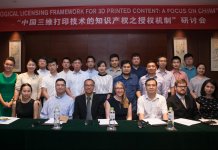
The AHRC research group will develop a global licensing platform for 3DP content.
Workshop in China tackled piracy issues caused by growing use of 3D printers
Dr James Griffin, and Dr Onyeka Osuji of Exeter Law School have been working to develop a solution to the growing problem of piracy caused by the increasing use of 3D printers.
Dr James Griffin, and Dr Onyeka Osuji of Exeter Law School have been working to develop an automated licensing solution to the growing problem of piracy caused by the increasing use of 3D printers.
The AHRC funded research project, which will run until December 2016, has been carried out in partnership with academics from the University of Nottingham Ningbo China, Durham University School of Law, the University of Sussex, and the Chinese University of Political Science and Law.
A workshop in August addressed the challenges in establishing intellectual property when disseminating 3D printing content and information sharing between important stakeholders amongst the value chain in 3D printing industry in China. Representative from 13 3D printing companies from Singapore, Shanghai, Hangzhou and Ningbo also attended the workshop.
The workshop consisted of three parts, namely the project introduction, demonstration of feasibility of watermarking technology in 3D printed content, and an open discussion session with five members of industry.
The availability of online 3D files, where creative designers upload their designs to Internet and interested makers can download the content, has led to an ambiguous relationship between the development of 3D printing industry and law of intellectual property.
The researchers from the collaborating universities have proposed an idea of automatic single automated copyright online licensing platform, where content can be automatically licensed through embedded watermarking system. This would facilitate back room payments to minimise disruption to users and maximise the re-use of content.
PhD candidate Jerry Niu has demonstrated the feasibility in embedding invisible watermarking in 3D model. By spatial transformations or spectral algorithms, this technique is able to hide copyright notices to the 3d digital contents without affecting the product use function. Moreover, the hidden information could be inversely extracted after being attacked by affine transformation, mesh simplification, noise, cropping and smoothing.
Applying this technology to the automated licensing platform, Niu believes it can effectively protect the intellectual property rights of the owner whilst opening up the freedom to re-use 3DP content.
Date: 12 September 2016
